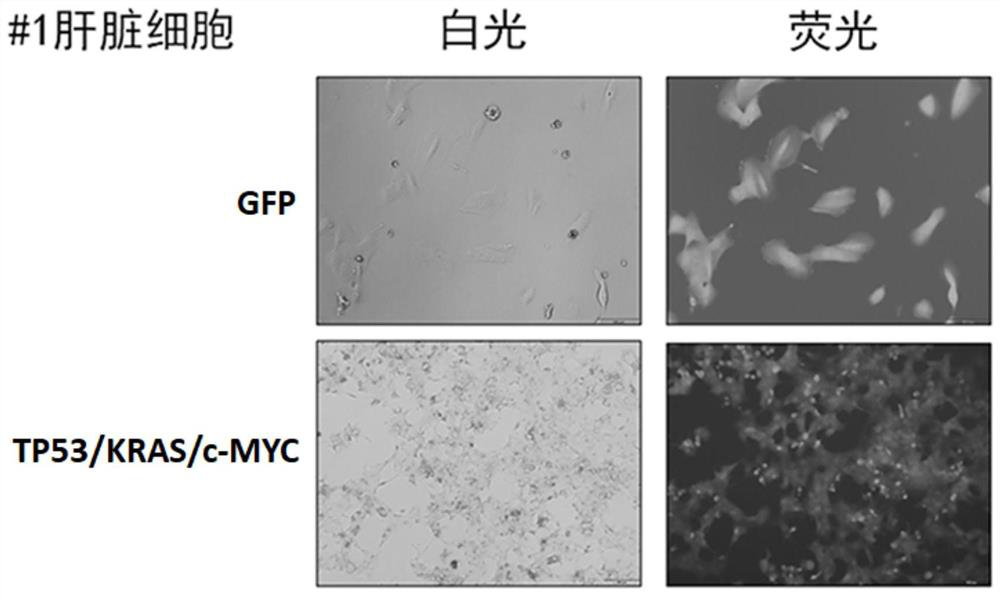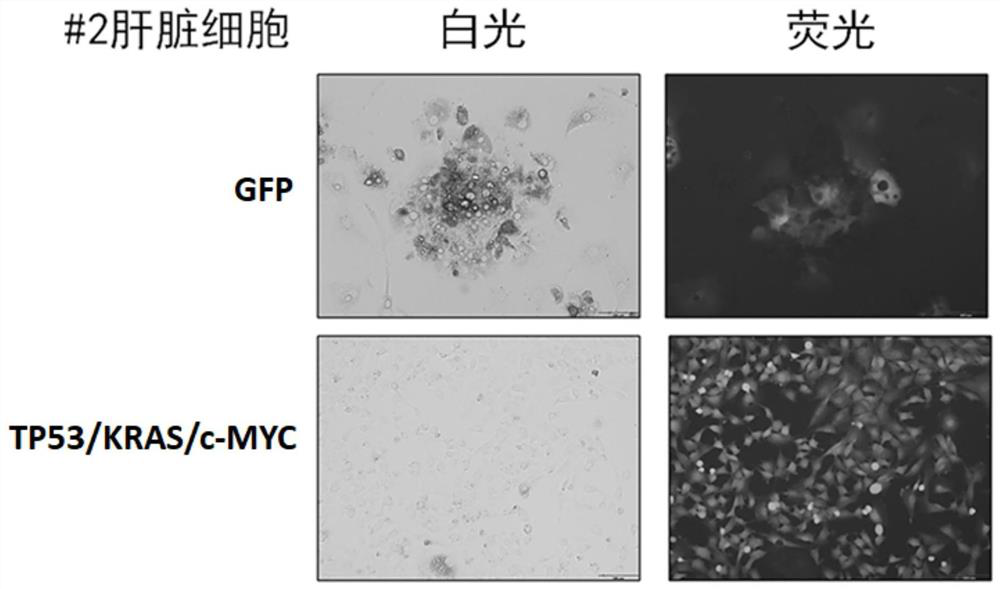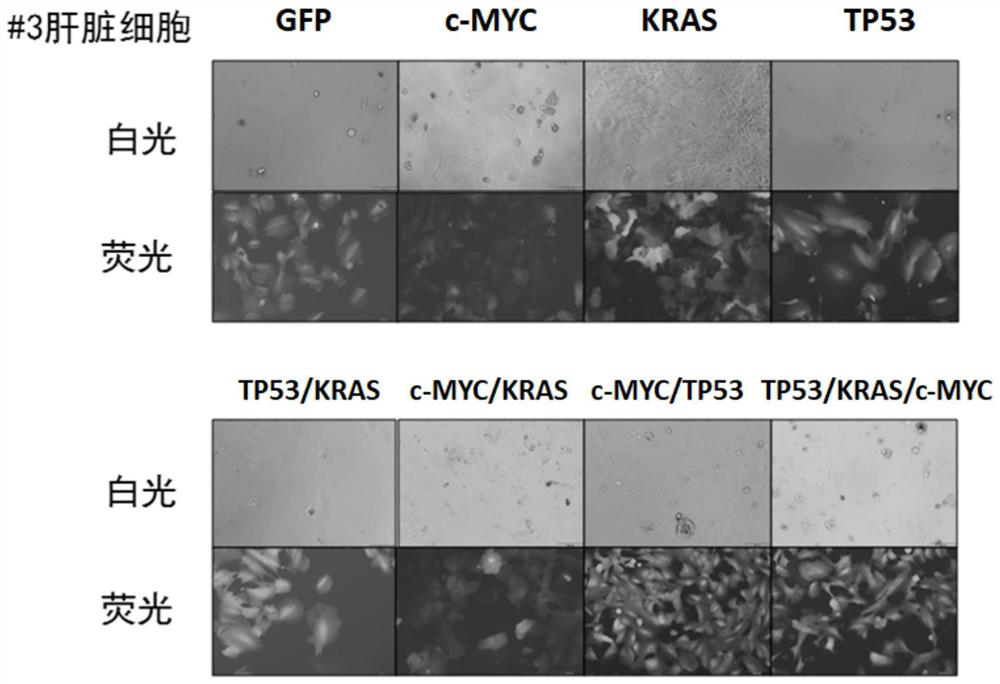Gene combination for inducing hepatocytes into live cancer cells and application of gene combination
A technology of gene combination and liver cancer cells, applied in the field of genetic engineering, can solve the problems of low transplantation efficiency, affecting application, unable to simulate liver cancer models, etc., and achieve the effect of high cancer rate.
- Summary
- Abstract
- Description
- Claims
- Application Information
AI Technical Summary
Problems solved by technology
Method used
Image
Examples
Embodiment 1
[0095] In this example, the TP53 / KRAS / c-MYC triple transgene was used to induce #1 primary liver cells to transform into liver cancer cells in vitro
[0096] (1) Culture of primary human hepatocytes
[0097] Adjust the hepatocyte concentration to 5 x 10 5 / cm 3 , inoculated in a 10cm culture dish, the medium was added with InVitroGRO CP hepatocyte medium, placed in 5% CO 2 After culturing in an incubator at 37°C for 4 hours, replace with fresh medium and remove unattached cells, and replace with fresh medium every two days.
[0098] (2) Lentiviral packaging
[0099] Inoculate 293T cells in a good state in a 10cm dish, and when the 293T cells grow to 70% confluence, starve and culture them with DMEM medium containing 1% FBS and 1% double antibody for 2 hours;
[0100] Add PEI (Polyethyleneimine, polyethyleneimine) (72 μg / dish) into opti-MEM (serum-free medium), mix well, and let stand at room temperature for 5 minutes;
[0101] Add the plasmids pWPXLd-TP53-2A-KRAS-2A-MYC-...
Embodiment 2
[0107] TP53 / KRAS / c-MYC triple transgene induces #2 primary liver cells to transform into hepatocellular carcinoma cells in vitro
[0108] Divide #2 liver cells into two groups, the TP53 / KRAS / c-MYC transduction experimental group and the GFP blank control group, and set up 3 replicate wells in each group, with the number of cells per well 1×10 6 Cultured in a 6-well plate culture dish, medium 2mL: DMEM containing 10% FBS and 1% double antibody, placed at 37°C, 5% CO 2 After culturing for 24 hours, the TP53 / KRAS / c-MYC and GFP lentivirus solutions obtained in step (2) in Example 1 were added respectively.
[0109] After 10 days, the cell proliferation and growth morphology of different experimental groups were observed, and the results were as follows: figure 2 shown.
[0110] It was found that the liver cells of the blank control group transfected with GFP grew slowly, the cell shape was irregular, did not grow in clusters, and there was contact inhibition; while the liver ce...
Embodiment 3
[0112] In this example, #3 primary liver cells were induced to transform into liver cancer cells in vitro by TP53 / c-MYC double transgene and TP53 / KRAS / c-MYC triple transgene.
[0113] (1) Lentiviral packaging
[0114] Inoculate 293T cells in a good state in a 10cm dish, and when the 293T cells grow to 80% confluence, starve and culture them with DMEM medium containing 1% FBS and 1% double antibody for 2 hours;
[0115] Add PEI (72 μg / dish) to opti-MEM, mix well, and let stand at room temperature for 5 minutes; mix 9 μg / dish of the plasmids in Table 1 with psPAX2 (12 μg / dish) and pMD2.G (3 μg / dish) respectively Add to opti-MEM and mix well;
[0116] Table 1
[0117]
[0118] Add the pre-mixed opti-MEM PEI medium to each plasmid medium at a ratio of 1:1, shake gently to mix, and then stand at room temperature for 20 minutes;
[0119]Add drop by drop to starved 293T cell culture dish, shake gently to mix, culture in 37°C incubator, change medium after 8 hours to continue cu...
PUM
 Login to View More
Login to View More Abstract
Description
Claims
Application Information
 Login to View More
Login to View More - R&D
- Intellectual Property
- Life Sciences
- Materials
- Tech Scout
- Unparalleled Data Quality
- Higher Quality Content
- 60% Fewer Hallucinations
Browse by: Latest US Patents, China's latest patents, Technical Efficacy Thesaurus, Application Domain, Technology Topic, Popular Technical Reports.
© 2025 PatSnap. All rights reserved.Legal|Privacy policy|Modern Slavery Act Transparency Statement|Sitemap|About US| Contact US: help@patsnap.com



